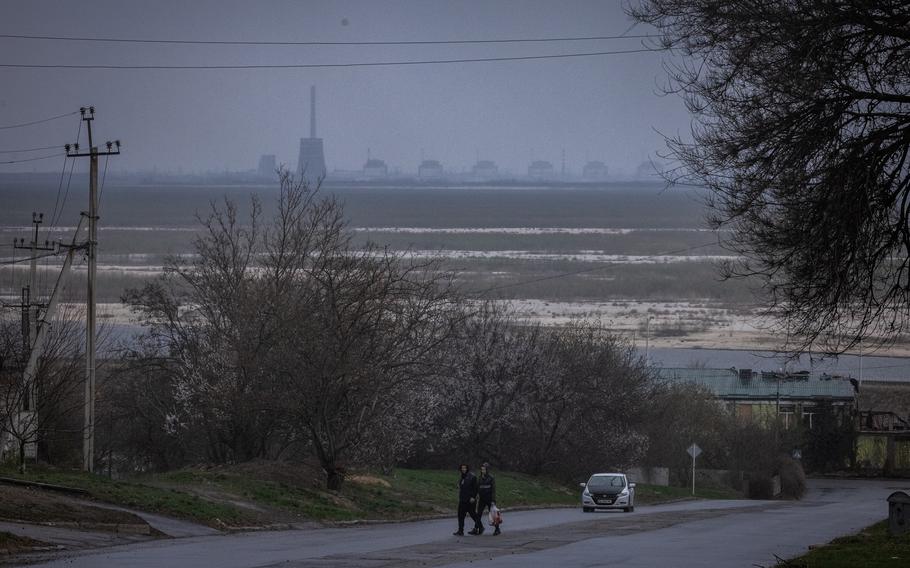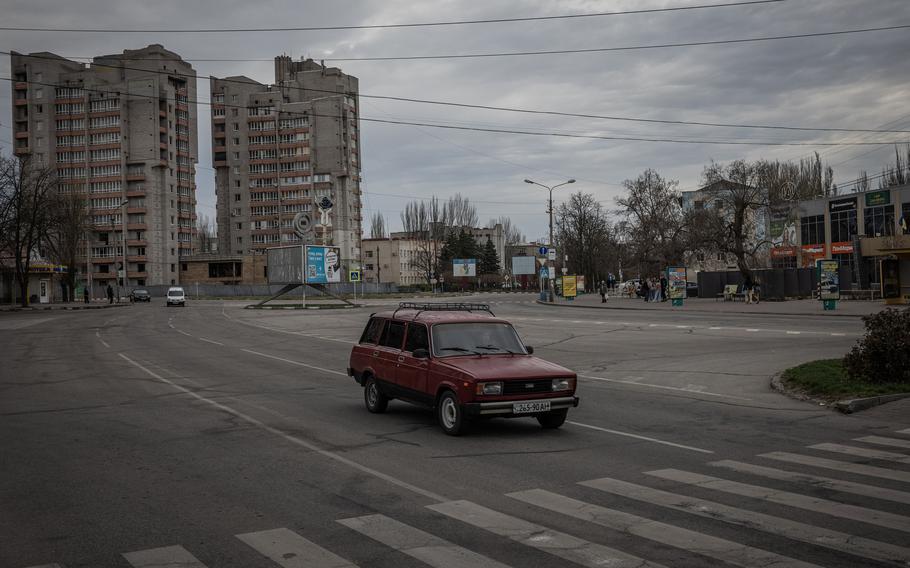Europe
Everyone wants Europe’s largest nuclear plant; Ukraine wants it back
The Washington Post April 7, 2025

People cross a road as the Zaporizhzhia nuclear power plant can be seen in the background on the Russian-controlled southern bank side of the Dnieper River on March 29 in Nikopol, Ukraine. (Ed Ram for The Washington Post)
NIKOPOL, Ukraine — For three years, Russia’s violent takeover of Europe’s largest nuclear power plant — which President Donald Trump recently said he wants to control — has haunted this city perched on the opposite riverbank, just four miles away.
The plumes of vapor billowing over the Zaporizhzhia nuclear power plant once symbolized Ukraine’s energy independence and economic prosperity, a reminder that the multibillion-dollar enterprise generated 2% of the country’s electricity — enough for factories to thrive in industrial cities like Nikopol and for Ukraine to export power to the rest of Europe.
But since Moscow’s 2022 occupation of the plant, the now-defunct facility in the town of Enerhodar serves instead as evidence of the Kremlin’s plan to subdue Ukraine’s economy, steal its vast industrial assets and thwart its hopes for an independent future in the European Union.
Locals in Nikopol now fear the silhouettes of the six nuclear reactors that loom over the river, the outlines of a facility they say has transformed into a military base that attacks them and no longer produces the energy the country needs to survive.
The White House, meanwhile, eager for a quick resolution to Russia’s war in Ukraine, has set its own sights on the plant — part of a process recouping the previous administration’s investment to support Ukraine’s defense.
American ownership of Ukraine’s nuclear plants “would offer the best protection for this infrastructure and support Ukraine’s energy needs,” White House press secretary Karoline Leavitt told reporters.
The suggestion deeply rattled Ukraine, which has already lost billions of dollars in state assets with Russia’s seizure of 20 percent of its sovereign territory. Kyiv has long seen its own eventual retaking of the plant as nonnegotiable for its economic independence and future security.
Ukrainian President Volodymyr Zelenskyy — who is already walking a fine line with the White House amid fears it could again cut security and intelligence aid to Ukraine — said he told Trump that the plant is a national entity that belongs to the state, but that Kyiv remains interested in economic cooperation.
The largest obstacle to any plans for the Zaporizhzhia plant remains the most obvious one: Russia currently controls it and insists that it is a part of Russia after it illegally annexed the whole Zaporizhzhia region.
“The return of the plant to the Russian nuclear industry is a long-established fact that the international community only needs to recognize,” the Russian Foreign Ministry declared on March 25. “The transfer of the ZNPP itself or control over it to Ukraine or any other country is impossible.”

About 7,000 buildings in Nikopol — shown here on March 29, 2025 — have been damaged and more than half of the city’s population has fled. (Ed Ram for The Washington Post)
For Ukrainians, perpetual Russian occupation of the plant is a worst-case scenario. It means Ukraine will continue to lose energy the plant once provided, while spending its limited reserves of electricity to keep the reactors cool and avoid a catastrophic nuclear disaster.
It means residents of Enerhodar, most of whom have fled, can never go home — and never restart the plant where thousands of them once worked. And for residents of Nikopol, it would mean a permanent existence on a front line.
Yurii Bahno, 40, interim head of the Nikopol military regional administration, said that since seizing the plant, Ukrainian intelligence has documented that Russian forces are using it to train recruits to practice artillery and drone strikes on his city. So far, 79 residents have been killed and 400 wounded.
About 7,000 buildings in Nikopol have been damaged and more than half of the city’s population has fled, he said.
The Russian Defense and Foreign ministries did not respond to a request for comment about the accusations but regularly claim Ukrainian forces shell the plant and conduct “nuclear terrorism.”
On a recent afternoon, as a Washington Post team visited Nikopol, residents Marina and Sasha ran out of their apartment building near the river, shouting a warning about the Russian drones constantly overhead. Their previous house was destroyed in shelling and now in this temporary apartment, they live under the constant threat of drones.
“You get used to it out of desperation,” Marina said.
This is the life Nikopol fears facing if Russia maintains control of the plant in any peace deal.
“The station definitely has to be under Ukrainian control,” Bahno said. “There should be no talk of giving it away. If we lose the station, it will be a massive blow to the economy and infrastructure.”
No one expected the Russians to attack the plant.
Even as Russian tanks rolled toward Kyiv, Kharkiv and other Ukrainian cities in February 2022, residents of Enerhodar were sure they were safe. The risks of attacking a nuclear power plant were so enormous that they assumed Russia wouldn’t dare target them. As Russian troops advanced, unarmed civilians poured into the streets to block them.
Then, on March 2, 2022, the Russians opened fire and routed the few Ukrainian troops left guarding the plant.
Enerhodar Mayor Dmytro Orlov, who now works from Ukrainian-controlled Zaporizhzhia city, said a nightmare has since unfolded in his hometown, which only has 20 percent of its preinvasion population.
The plant used to operate with more than 10,000 employees. Now there is a bare-bones staff — some of them experts who stayed to try to prevent nuclear disaster and others who are inexperienced new hires Russia has recruited to replace those who fled. A small percentage of residents are probably willingly collaborating with the Russians, Orlov said.
Russia has detained or tortured more than 1,000 Ukrainian civilians from Enerhodar since its takeover of the city, including the former deputy mayor, who was held for nearly a year, according to data from Orlov’s office. At least 21 civilians from the town, most of them employees of the plant, have been slapped with lengthy prison sentences. Ukraine says the allegations are fabricated.
Many more civilians have been threatened and forced to work at the plant, take Russian passports and sign contracts with Rosatom, the Russian state atomic energy corporation. The Russian Foreign Ministry insists that all employees of the station are citizens of the Russian Federation and so they cannot be under Ukrainian authority.
“Only if it’s under Ukrainian control can it be fully safe again,” Orlov said, describing any U.S. interest in the plant as “definitely positive.”
“We are interested in the de-occupation of the station and the city,” he said. “The only people who don’t like this idea are the Russians.”
Irina Artiukhova, 35, a plant employee responsible for water purification at the facility, is among those most desperate for discussions to be held about the return of civilian prisoners — her husband, also a plant worker, was taken.
Artiukhova initially kept working at the plant after the Russian occupation, but then on June 19, 2023, Russian men in plainclothes came to her cottage, blindfolded her and drove her to the central police station.
Inside, she said, Russian officials demanded information about her husband, Serhii Potyn, a volunteer who helped distribute supplies to civilians. She didn’t know where he was that day or why they wanted him — but they tried to pry information out of her by dousing her with water and electrocuting her with clips attached to her ears and toes.
She was released a week later, after they found her husband and detained him. She fled the city to reunite with the couple’s son, who is now 11, and her mother, who had moved to Turkey. Her husband was sentenced to 19 years in prison on charges of terrorism. Their only communication since has been one censored letter per month.
“The knowledge of people who are in captivity is very valuable to the Ukrainian energy system, and we need them back,” she said.
Natalia, 57, who worked in the plant but fled to Zaporizhzhia city and spoke on the condition that her last name not be used because her husband remains in Enerhodar, said Russian troops raided her home three times before she finally fled in spring 2023. She is desperate to return home and to restart the station, even if it “will be a shell of a city or a ghost town.”
But “we are not a colony,” she said, and the plant must remain Ukrainian.
For his part, Volodymyr Kravchuk, 64, who spent decades as a technician and trainer at the plant, said, he doesn’t mind if Trump takes it over — if it means the Russians finally leave. “You can even convert it to the 51st state instead of Canada,” he said, “if it means I can go back home.”
Natalia Abbakumova in Riga, Latvia, contributed to this report.